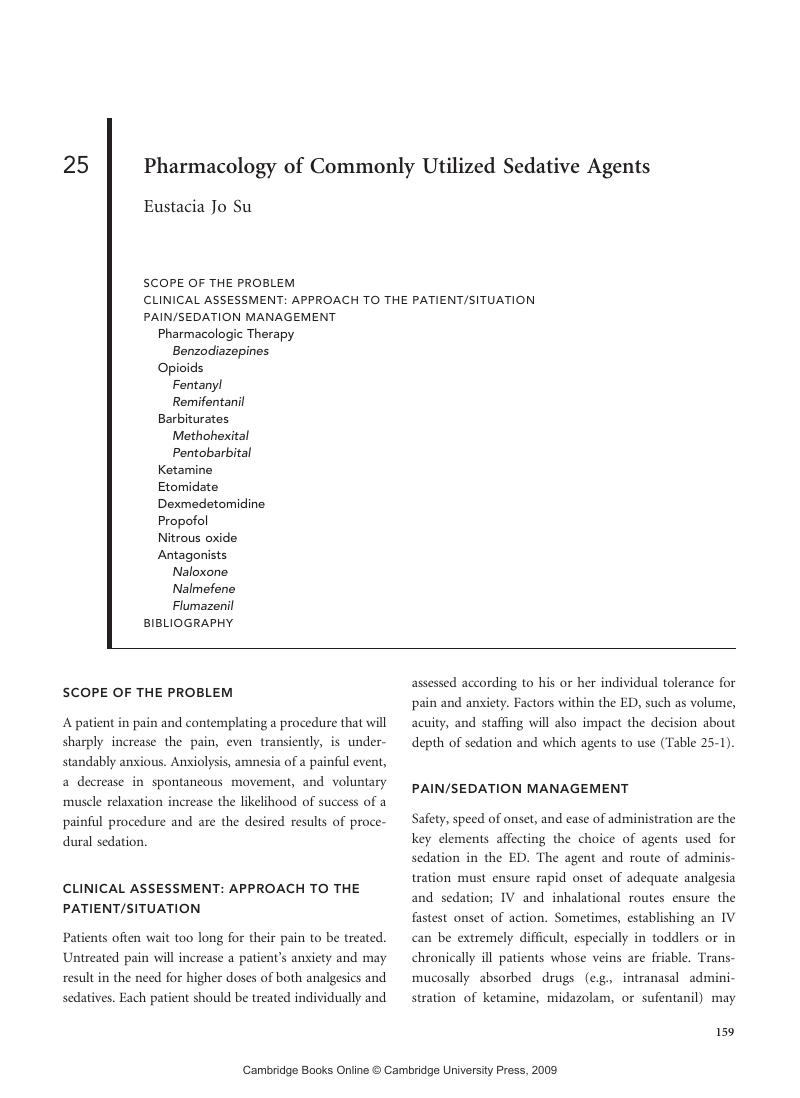Book contents
- Frontmatter
- Contents
- Acknowledgments
- List of Contributors
- SECTION ONE OVERVIEW AND PRINCIPLES IN EMERGENCY ANALGESIA AND PROCEDURAL SEDATION
- SECTION TWO ANALGESIA FOR THE EMERGENCY PATIENT
- SECTION THREE PROCEDURAL SEDATION FOR THE EMERGENCY PATIENT
- 23 Patient Assessment and Preprocedure Considerations
- 24 Monitoring for Procedural Sedation
- 25 Pharmacology of Commonly Utilized Sedative Agents
- 26 Procedural Sedation for Pediatric Laceration Repair
- 27 Procedural Sedation for Pediatric Radiographic Imaging Studies
- 28 Procedural Sedation for Brief Pediatric Procedures: Foreign Body Removal, Lumbar Puncture, Bone Marrow Aspiration, Central Venous Catheter Placement
- 29 Procedural Sedation for Adult and Pediatric Orthopedic Fracture and Joint Reduction
- 30 Procedural Sedation for Electrical Cardioversion
- 31 Procedural Sedation for Brief Surgical Procedures: Abscess Incision and Debridement, Tube Thoracostomy, Nasogastric Tube Placement
- SECTION FOUR TOPICAL, LOCAL, AND REGIONAL ANESTHESIA APPROACH TO THE EMERGENCY PATIENT
- SECTION FIVE SPECIAL CONSIDERATIONS FOR EMERGENCY PROCEDURAL SEDATION AND ANALGESIA
- Index
- Plate section
- References
25 - Pharmacology of Commonly Utilized Sedative Agents
from SECTION THREE - PROCEDURAL SEDATION FOR THE EMERGENCY PATIENT
Published online by Cambridge University Press: 03 December 2009
- Frontmatter
- Contents
- Acknowledgments
- List of Contributors
- SECTION ONE OVERVIEW AND PRINCIPLES IN EMERGENCY ANALGESIA AND PROCEDURAL SEDATION
- SECTION TWO ANALGESIA FOR THE EMERGENCY PATIENT
- SECTION THREE PROCEDURAL SEDATION FOR THE EMERGENCY PATIENT
- 23 Patient Assessment and Preprocedure Considerations
- 24 Monitoring for Procedural Sedation
- 25 Pharmacology of Commonly Utilized Sedative Agents
- 26 Procedural Sedation for Pediatric Laceration Repair
- 27 Procedural Sedation for Pediatric Radiographic Imaging Studies
- 28 Procedural Sedation for Brief Pediatric Procedures: Foreign Body Removal, Lumbar Puncture, Bone Marrow Aspiration, Central Venous Catheter Placement
- 29 Procedural Sedation for Adult and Pediatric Orthopedic Fracture and Joint Reduction
- 30 Procedural Sedation for Electrical Cardioversion
- 31 Procedural Sedation for Brief Surgical Procedures: Abscess Incision and Debridement, Tube Thoracostomy, Nasogastric Tube Placement
- SECTION FOUR TOPICAL, LOCAL, AND REGIONAL ANESTHESIA APPROACH TO THE EMERGENCY PATIENT
- SECTION FIVE SPECIAL CONSIDERATIONS FOR EMERGENCY PROCEDURAL SEDATION AND ANALGESIA
- Index
- Plate section
- References
Summary

- Type
- Chapter
- Information
- Emergency Sedation and Pain Management , pp. 159 - 167Publisher: Cambridge University PressPrint publication year: 2008

